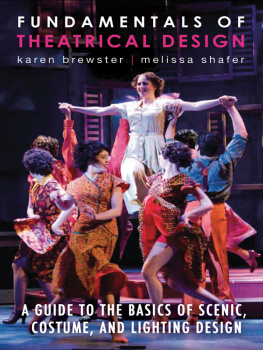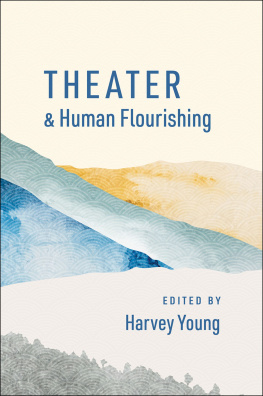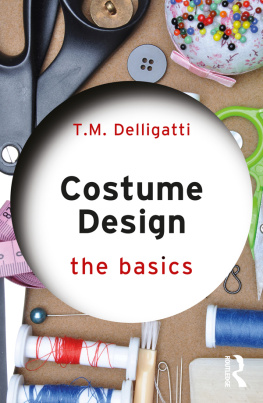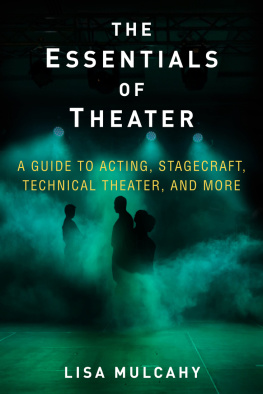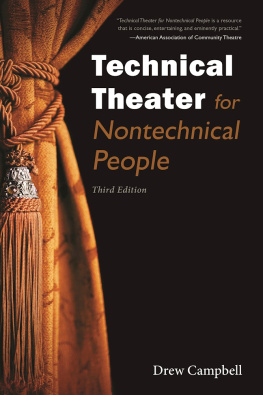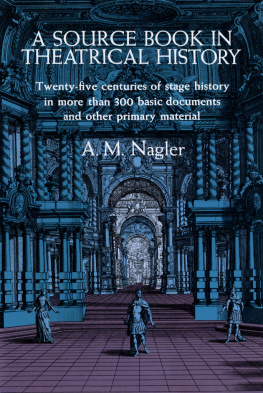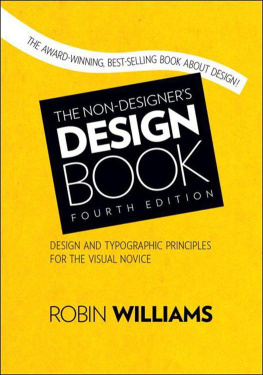FUNDAMENTALS OF THEATRICAL DESIGN
FUNDAMENTALS OF THEATRICAL DESIGN
karen brewster
melissa shafer

2011 by Karen Brewster and Melissa Shafer
All rights reserved. Copyright under Berne Copyright Convention, Universal Copyright Convention, and Pan American Copyright Convention. No part of this book may be reproduced, stored in a retrieval system, or transmitted in any form, or by any means, electronic, mechanical, photocopying, recording or otherwise, without the express written consent of the publisher, except in the case of brief excerpts in critical reviews or articles. All inquiries should be addressed to Allworth Press, 307 West 36th Street, 11th Floor, New York, NY 10018.
Allworth Press books may be purchased in bulk at special discounts for sales promotion, corporate gifts, fund-raising, or educational purposes. Special editions can also be created to specifications. For details, contact the Special Sales Department, Allworth Press, 307 West 36th Street, 11th Floor, New York, NY 10018 or info@skyhorsepublishing.com.
15 14 13 12 11 5 4 3 2 1
Published by Allworth Press
An imprint of Skyhorse Publishing
307 West 36th Street, New York, NY 10018.
Allworth Press is a registered trademark of Skyhorse Publishing, Inc., a Delaware corporation.
www.allworth.com
Cover design by Natalya Balnova
Library of Congress Cataloging-in-Publication Data
Brewster, Karen, 1955
Fundamentals of theatrical design / by Karen Brewster and Melissa Shafer.
p. cm.
ISBN 978-1-58115-849-6
1. Theaters--Stage-setting and scenery. 2. Set designers. 3. Stage management. I. Shafer,
Melissa. II. Title.
PN2091.S8.B6675 2011
792.025--dc22
2011000710
Printed in Canada
Dedication
We extend our love and gratitude to our families:
Lois and Ed Shafer, Nancy and Bill Brewster
Dick, Shannon, and Will Major
Your unconditional support made this book possible.
We are grateful to our colleagues and students at East Tennessee State University, and especially thank Dr. Burt Bach, Dr. Gordon Anderson, Dr. Charles Roberts, Dr. Amber Kinser, and Mr. Pat Cronin for making it possible for us to undertake this journey. We also wish to thank Mr. Larry Smith and the ETSU Photo Lab for their artistry and technical know-how.
We are equally indebted to the many artists who generously contributed their time and talents to the illustrations in this book: Ms. Amanda Aldridge, Resident Costume Designer for Barter Theatre; Ms. Alice Anthony, Associate Professor of Art at Milligan College; Ms. Samantha Bostwick, Instructor in Production Studies at Arizona School for the Arts; Mr. David Brandon, Assistant Professor of Theatre Design at Austin Peay State University; Mr. Brad Carlson, Technical Director/Designer at the University of Wisconsin Platteville; Ms. Amber Marisa Cook, Costume Designer/Shop Supervisor at Albion College; Mr. Daniel Ettinger, Professor of Theatre Arts at Towson University; Ms. Sandy Leppin, Oklahoma State University; Ms. Donna Meester, Associate Professor of Theatre at University of Alabama Tuscaloosa; Mr. Justin A. Miller, Assistant Professor of Theatre and Technical Director at Texas A&M University; Dr. Ronald Naversen, Professor of Scenic Design at Southern Illinois University Carbondale; Ms. Jodi Ozimek, Assistant Professor of Costume Design at Michigan State University; Mr. Jordan Straight, Graduate Assistant at the University of Alabama Tuscaloosa; Mr. Jonathon Taylor, Graduate Assistant at the University of Oregon; and Ms. Cynthia Turnbull, Chair and Associate Professor of Theatre at Denison University.
Several photographs in this book were provided by Mr. Rick Rose, Producing Artistic Director of the Barter Theatre, and Ms. Leah Prater of the Barter Theatre Marketing Department. We appreciate their generosity of both time and materials. Additionally, the willingness of the departments of theatre at the following schools to give permission for us to use photographs is gratefully acknowledged: East Tennessee State University, Michigan State University, Milligan College, Southern Illinois University Carbondale, Towson University, University of Alabama Tuscaloosa, and special thanks to Dr. Ronald Naversen, Professor of Theatre at Southern Illinois University Carbondale, for his help in procuring illustrations.
Thanks to Mr. David Grindle and the United States Institute for Theatre Technology for permission to reproduce information and materials from their graphics standards publications, and Mr. Ken Dingledine, Publications Manager for Samuel French, Inc., for taking time to generously answer questions regarding play publishing practices. Additionally, we extend our thanks to Ms. Jessica Adams, Mr. Aaron Ashley, Mr. William Cate, Ms. Leslie Epling, Mr. Samuel Floyd, Mr. Will Major, Ms. Constance Claypool Mohr, Ms. Rachel Lee-Ann Pitts, and Mr. Terrence Stockton for their willingness to serve as test subjects on several of the exercises in this book. We also thank Ms. Erin Estep Dugger for providing much-needed clerical support.
Special thanks are reserved for the artists and educators who served as readers and evaluators of this work: Ms. Gretel Geist Rutledge, Professor Emerita of Production Design at Michigan State University; Ms. Cynthia Lybrand, Medical Education Coordinator for ETSUs Quillen College of Medicine; Mr. Richard Major, Professor and Chair of Theatre at Milligan College; Ms. Jodi Ozimek, Assistant Professor of Costume Design at Michigan State University; and Mr. Jonathon Taylor, Graduate Assistant at the University of Oregon. Their contributions to this project were invaluable.
Theater textbooks often begin with a definition of what theater is. While this may seem trite, the reason for posing this question is valid. In order to effectively practice an art form, one must understand what defines that art form. It is a given that many of the fine arts, such as sculpture, painting, and literature, create concrete and tangible works. And while it can be said that theater is an amalgamation of many of these same art forms, the essential art of theater is found in the exchange that happens between artists and audience during a live performance. The art of theater is a transitory, shared, and empathetic encounter involving the intimate examination of the lives, thoughts, and feelings of other people.
What is our purpose on this planet? Why do some individuals suffer, and some individuals prosper? Why do we love? Hate? The creative impulse shared by all people and cultures across time attempts to address these eternal questions. Throughout human history, we have used artand particularly theaterto give voice to these questions and to postulate answers. That is the core of why we write and perform plays. Questioning the meaning and purpose of our lives defines our humanity. We learn about ourselves when we examine the lives of others. It is also important to note that it is the immediacy of this art form that draws us to it; the experience of live theater is much like life itself in that both life and theater are ever changing, at times fleeting and momentary.
While theater art is evanescent and fleeting, its creation is a lengthy collaborative process. Theater is created by artists who each methodically share their expertise in a number of disciplines: playwrights; scenic and properties designers; costume, hair, and makeup designers; lighting, sound, and projection designers; directors and actors; and a legion of craftspersons. On any given production, these theater artisans create the world of the play based on the playwrights words. Set and lighting designers create the environment in which the characters live and breathe; costume designers, along with the actors, create the characters that inhabit this world. At the heart of making the art of theater is the excitement that comes from this collaboration, and the realization that this art form is indeed ephemeralno two productions, or even performances, of the same play will ever be exactly alike.
Next page
